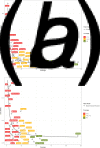Correlation of population mortality of COVID-19 and testing coverage: a comparison among 36 OECD countries
- PMID: 33413705
- PMCID: PMC7804083
- DOI: 10.1017/S0950268820003076
Correlation of population mortality of COVID-19 and testing coverage: a comparison among 36 OECD countries
Abstract
Although testing is widely regarded as critical to fighting the COVID-19 pandemic, what measure and level of testing best reflects successful infection control remains unresolved. Our aim was to compare the sensitivity of two testing metrics - population testing number and testing coverage - to population mortality outcomes and identify a benchmark for testing adequacy. We aggregated publicly available data through 12 April on testing and outcomes related to COVID-19 across 36 OECD (Organization for Economic Development) countries and Taiwan. Spearman correlation coefficients were calculated between the aforementioned metrics and following outcome measures: deaths per 1 million people, case fatality rate and case proportion of critical illness. Fractional polynomials were used to generate scatter plots to model the relationship between the testing metrics and outcomes. We found that testing coverage, but not population testing number, was highly correlated with population mortality (rs = -0.79, P = 5.975 × 10-9vs. rs = -0.3, P = 0.05) and case fatality rate (rs = -0.67, P = 9.067 × 10-6vs. rs = -0.21, P = 0.20). A testing coverage threshold of 15-45 signified adequate testing: below 15, testing coverage was associated with exponentially increasing population mortality; above 45, increased testing did not yield significant incremental mortality benefit. Taken together, testing coverage was better than population testing number in explaining country performance and can serve as an early and sensitive indicator of testing adequacy and disease burden.
Keywords: COVID-19; SARS-CoV-2; testing coverage.
Conflict of interest statement
The authors disclose no conflicts of interest.
Figures


Similar articles
-
The association between various indicators of hospital capacity, age category, and the number of screening tests performed with case fatality rate and recovery rate during the COVID-19 disease pandemic.J Prev Med Hyg. 2021 Jul 30;62(2):E261-E269. doi: 10.15167/2421-4248/jpmh2021.62.2.1569. eCollection 2021 Jun. J Prev Med Hyg. 2021. PMID: 34604564 Free PMC article.
-
The effect of laboratory testing on COVID-19 monitoring indicators: an analysis of the 50 countries with the highest number of cases.Epidemiol Serv Saude. 2021;30(2):e2020722. doi: 10.1590/S1679-49742021000200002. Epidemiol Serv Saude. 2021. PMID: 34008747 English, Portuguese.
-
The Global Health Security Index is not predictive of vaccine rollout responses among OECD countries.Int J Infect Dis. 2021 Dec;113:7-11. doi: 10.1016/j.ijid.2021.09.034. Epub 2021 Sep 20. Int J Infect Dis. 2021. PMID: 34547494 Free PMC article.
-
Comparison of COVID-19 Pandemic Waves in 10 Countries in Southern Africa, 2020-2021.Emerg Infect Dis. 2022 Dec;28(13):S93-S104. doi: 10.3201/eid2813.220228. Emerg Infect Dis. 2022. PMID: 36502398 Free PMC article. Review.
-
COVID-19 in African Countries versus other World Regions: A Review.Afr J Reprod Health. 2020 Jun;24(s1):125-141. doi: 10.29063/ajrh2020/v24i2s.17. Afr J Reprod Health. 2020. PMID: 34077062 Review.
Cited by
-
Modeling the change in European and US COVID-19 death rates.PLoS One. 2022 Aug 17;17(8):e0268332. doi: 10.1371/journal.pone.0268332. eCollection 2022. PLoS One. 2022. PMID: 35976910 Free PMC article.
-
Burden of COVID-19 and case fatality rate in Pune, India: an analysis of the first and second wave of the pandemic.IJID Reg. 2022 Mar;2:74-81. doi: 10.1016/j.ijregi.2021.12.006. Epub 2021 Dec 18. IJID Reg. 2022. PMID: 35721428 Free PMC article.
-
Association of government effectiveness, logistics performance, IT systems and income with COVID-19 mortality.Heliyon. 2023 Apr;9(4):e15214. doi: 10.1016/j.heliyon.2023.e15214. Epub 2023 Apr 5. Heliyon. 2023. PMID: 37035369 Free PMC article.
-
Is COVID-19 mortality associated with test number?J Family Med Prim Care. 2022 May;11(5):1842-1844. doi: 10.4103/jfmpc.jfmpc_1633_21!. Epub 2022 May 14. J Family Med Prim Care. 2022. PMID: 35800487 Free PMC article.
-
A discussion on the minimum required number of tests in two common pooling test methods for SARS-CoV-2.Epidemiol Infect. 2021 Aug 3;149:e179. doi: 10.1017/S0950268821001667. Epidemiol Infect. 2021. PMID: 34340721 Free PMC article.
References
-
- COVID-19 Map. Johns Hopkins Coronavirus Resource Center. Available at https://coronavirus.jhu.edu/map.html (Accessed 14 May 2020).
-
- Correcting under-reported COVID-19 case numbers: estimating the true scale of the pandemic|medRxiv. Available at https://www.medrxiv.org/content/10.1101/2020.03.14.20036178v2 (Accessed 24 April 2020).
MeSH terms
LinkOut - more resources
Full Text Sources
Medical
Miscellaneous

